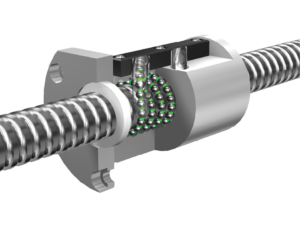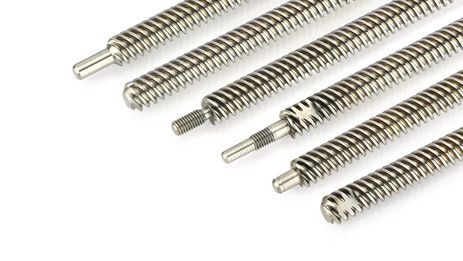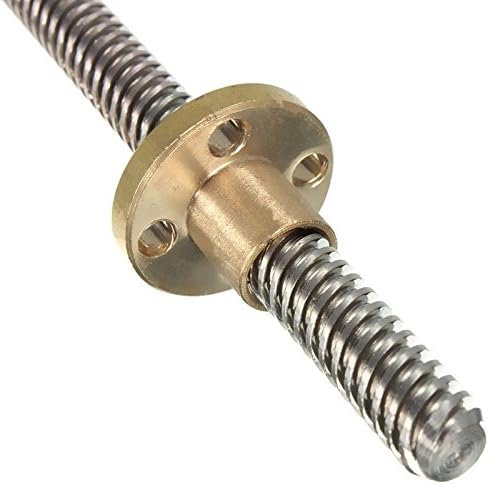Product Description
Product Description
| Brand | TOCO |
| Precision | C7&C5 rolled, C5&C3 grinding |
| Model | SFK,SFU,DFU,SFE,SFS,DFS,SFI,DFI,SCI |
| Size customize | Dia: 12,16,20,25,32,40,50,63,80mm| Lead: 5,6,8,10,16,20,25,32,40,80mm |
| Maximum length | 1000MM~7500MM,different diameter maximum length are different |
| HS CODE | 8483900090,8483457100 |
| Items packing | Plastic bag+Cartons Or Wooden Packing |
| Payment terms | T/T , Western Union |
| Production lead time | 5~7 days for sample , 15~30 days for the bulk |
| Ball Screw | Keyword |
| Application | CNC machines, Printing Machine ,Paper-processing machine Machine tool, Solar energy equipment, Medical equipment |
Company information:
HangZhou CHINAMFG Transmission Machinery Co., Ltd, is a specialized manufacturer in linear motion
products in China, which was established in 1999. Based on the strong technical strength, outstanding
quality, and high capacity, we have a good reputation both in China and abroad, and now we have many
customers all over the world. Our main products are ball screw, ball spline, linear guide, linear bearing,
mono stage, machine tool spindle, ball screw support unit, and locknut. You may find more information
on our website at www.toco.tw.
Marketing & Shipping:
1.Package: Carton or wooden case
2.Delivery time: 15 days after receiving the deposit
3.Shipping: by express (DHL, TNT, FedEx, etc.) or by sea
FAQ :
1. Service :
a. Help customers to choose the correct model, with CAD & PDF drawing for your reference.
b. Professional sales team, make your purchase smooth.
2.payment :
Sample order: We require 100% T/T in advance. sample express need request pay by clients
Bulk order: 30% T/T in advance, balance by T/T against copy of B/L.T/T, Paypal, Western Union is
acceptable.
3.Delivery :
sample: 5-10 business days after payment confirmed.
Bulk order:10-20 workdays after deposit received.
4. Guarantee Time
CHINAMFG provides a one-year quality guarantee for the products from your purchase date, except for
the artificial damage.
5.After sale-Service
During the warranty period, any quality problem of the CHINAMFG product, once confirmed, we will
send a new 1 to replace.
/* January 22, 2571 19:08:37 */!function(){function s(e,r){var a,o={};try{e&&e.split(“,”).forEach(function(e,t){e&&(a=e.match(/(.*?):(.*)$/))&&1
| Precision: | C7 |
|---|---|
| Screw Diameter: | 31-40mm |
| Flange: | With Flange |
| Nut Number: | Single |
| Rows Number: | 4-Row |
| Nut Type: | Circulator |
| Samples: |
US$ 40/Piece
1 Piece(Min.Order) | |
|---|
| Customization: |
Available
|
|
|---|

What role do lead screws play in ensuring proper alignment and tightness in mechanical assemblies?
Lead screws play a crucial role in ensuring proper alignment and tightness in mechanical assemblies. They provide a reliable means of applying axial force to securely fasten components together. Here’s how lead screws contribute to alignment and tightness:
Alignment:
Lead screws aid in achieving proper alignment in mechanical assemblies through the following mechanisms:
- Linear Motion: Lead screws convert rotary motion into linear motion, allowing for controlled movement and alignment of components. By rotating the lead screw, the connected nut or threaded component moves along the screw’s axis, enabling precise positioning and alignment of the assembly.
- Thread Engagement: The mating threads of the lead screw and nut provide a positive mechanical connection. As the nut moves along the screw, the threads engage tightly, ensuring accurate alignment between the screw and the nut. This thread engagement helps maintain the desired position and alignment of components within the assembly.
- Guidance and Support: Lead screws often incorporate guidance mechanisms, such as linear bearings or sliding surfaces, to ensure smooth and accurate linear motion. These guidance systems help prevent lateral movement, minimize misalignment, and maintain the intended trajectory of the assembly, improving overall alignment.
- Positioning Accuracy: Lead screws offer precise positioning capabilities, allowing for the accurate alignment of components. The thread pitch and design, combined with the rotational input, enable controlled linear movement and positioning. This precision is critical in applications where proper alignment is essential for optimal performance and functionality.
Tightness:
Lead screws contribute to achieving tightness and secure fastening in mechanical assemblies through the following means:
- Axial Force Application: Lead screws transmit axial force to clamp or tighten components together. By rotating the lead screw, the axial force is applied through the nut or threaded component, generating a clamping action that holds the assembly tightly. This axial force helps prevent loosening, vibration, or unintended movement of the connected components.
- Self-Locking Capability: Lead screws possess a self-locking characteristic, which means they can hold their position without the need for additional locking mechanisms. The friction between the mating threads provides resistance to back-driving and helps maintain the tightness of the assembly. This self-locking property ensures that the assembly remains securely fastened, even in the absence of continuous power input.
- Thread Friction: The friction between the mating threads of the lead screw and nut contributes to the tightness of the assembly. When properly lubricated, the thread friction helps increase the resistance to loosening or undesired movement. By controlling the thread friction, the tightness of the assembly can be optimized to meet the specific requirements of the application.
- Preload Adjustment: Lead screws allow for preload adjustment, which is the intentional application of axial force to achieve a desired level of tightness. Preload can be applied by adjusting the initial position of the nut along the lead screw or by incorporating preload mechanisms, such as spring washers or Belleville washers. Preload optimization ensures that the assembly remains tight and secure, even under varying loads or external disturbances.
Overall, lead screws provide a reliable means of achieving proper alignment and tightness in mechanical assemblies. Their linear motion capabilities, thread engagement, guidance mechanisms, positioning accuracy, axial force application, self-locking capability, and preload adjustability all contribute to ensuring the stability, alignment, and tightness of the assembled components.

How does the choice of lead screws affect the overall performance and reliability of linear motion systems?
The choice of lead screws has a significant impact on the overall performance and reliability of linear motion systems. Different types of lead screws offer distinct characteristics and capabilities that influence factors such as accuracy, load capacity, speed, efficiency, backlash, and durability. Here are some key ways in which the choice of lead screws affects the performance and reliability of linear motion systems:
- Accuracy and Precision: The selection of an appropriate lead screw type can directly impact the accuracy and precision of linear motion systems. Lead screws with fine thread pitches or multiple starts provide higher resolution and finer positioning capabilities, resulting in improved accuracy. Choosing a lead screw with low backlash and minimal axial play helps maintain precise motion control and repeatability.
- Load Capacity: Different lead screw designs have varying load-carrying capacities. Factors such as the diameter, pitch, material, and thread type influence the ability of a lead screw to handle axial loads. Selecting a lead screw with sufficient load capacity ensures the system can handle the required loads without compromising performance or risking premature failure.
- Speed and Efficiency: Lead screw selection affects the speed and efficiency of linear motion systems. Coarser thread pitches enable faster linear speeds, making them suitable for applications that require rapid movement. However, finer thread pitches offer increased mechanical advantage and torque conversion efficiency, making them preferable for systems requiring higher force output.
- Backlash and Repeatability: Backlash, the clearance between the lead screw and nut, can impact the accuracy and repeatability of linear motion systems. The choice of lead screw influences the amount of backlash present. Lead screws with low backlash or anti-backlash mechanisms minimize positioning errors and ensure consistent repeatability, enhancing system performance and reliability.
- Lubrication and Maintenance: Different lead screw materials and designs require specific lubrication and maintenance practices to ensure optimal performance and longevity. Some lead screws may require periodic lubrication, while others may be self-lubricating or require minimal maintenance. Choosing a lead screw that aligns with the maintenance capabilities and requirements of the system simplifies upkeep and reduces the risk of premature wear or failure.
- Environmental Considerations: The choice of lead screws should also take into account the environmental conditions in which the linear motion system will operate. Factors such as temperature, humidity, exposure to contaminants, or corrosive agents can impact the performance and reliability of lead screws. Selecting lead screws with appropriate materials, surface treatments, or protective coatings ensures compatibility with the intended operating environment.
It is crucial to carefully assess the specific requirements of the linear motion system and consider factors such as load capacity, accuracy, speed, backlash, maintenance, and environmental conditions when choosing a lead screw. Consulting with manufacturers, engineers, or industry experts can provide valuable insights and guidance to select the most suitable lead screw for achieving optimal performance, reliability, and longevity in a given application.

What is a lead screw, and how is it used in mechanical applications?
A lead screw is a type of threaded shaft used in mechanical applications to convert rotary motion into linear motion or vice versa. It consists of a screw with a helical thread and a matching nut with corresponding threads. The lead screw and nut are designed in such a way that when the screw is rotated, it moves the nut along its length, resulting in linear motion.
The primary purpose of a lead screw is to transmit motion and force between rotating and linearly translating components in a mechanical system. It offers precise control over linear movement and is commonly used in various applications, including but not limited to:
- Precision Positioning: Lead screws are widely used in applications that require precise positioning, such as CNC machines, 3D printers, and robotic systems. By coupling the lead screw to a motor or handwheel, the rotational motion can be translated into precise linear movement, allowing for accurate positioning of components or tools.
- Actuation and Adjustment: Lead screws are often utilized for actuation and adjustment mechanisms in equipment and machinery. They can be employed to raise or lower platforms, adjust the height of work surfaces, control the position of tool heads, or move components along a linear path. Lead screws provide a straightforward and reliable means of achieving controlled linear motion in these applications.
- Load Transfer: Lead screws can also serve as load-bearing elements in mechanical systems. They can transmit axial loads and handle tension or compression forces, making them suitable for applications that require smooth and controlled lifting or lowering of heavy loads. In such cases, the lead screw is often combined with thrust bearings or other supporting elements to handle the applied loads.
- Manual and Handwheel Operations: Lead screws are commonly used in manual and handwheel-operated systems. By incorporating a handle or handwheel, the user can rotate the lead screw directly, enabling manual adjustment or movement of components. This is frequently seen in applications like manual stage positioning, height adjustment mechanisms, or manual clamping systems.
- Power Transmission: In some cases, lead screws can be employed for power transmission purposes. While they are not as efficient as other transmission methods like gears or belts, lead screws can be used to transfer torque between rotating shafts and linearly translating components. This is often seen in applications where the primary focus is on converting rotational motion into linear motion rather than optimizing power transmission efficiency.
Lead screws come in various designs, including single-start and multi-start threads, different thread pitches, and varying lead screw and nut materials. The selection of a lead screw depends on the specific requirements of the application, such as load capacity, desired speed, precision, and environmental conditions. Factors like backlash, efficiency, and maintenance requirements should also be considered when choosing a lead screw for a particular mechanical application.


editor by Dream 2024-04-30